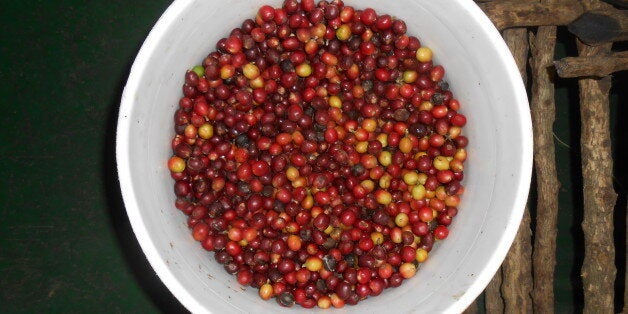
"Citrus? Wood?" I slurped another gulp of coffee and thought hard. "Chocolate, perhaps?" Ulises, who was patiently taking me through a cupping session on the verandah of Finca Rosa Blanca, just smiled. Ten minutes earlier, at the start of the tasting, I was struggling to pick out any specific flavours. The coffee, made by the traditional Costa Rican chorreador drip method, just tasted delicious. But gradually, thanks to Ulises' guidance, my palate developed, and I began to distinguish different flavours, sensing peanuts, floral scents, even leather. Or at least I think I did: Ulises may just have been too polite to correct me.
Earlier in the day he had taken me on a tour of the coffee estate attached to Finca Rosa Blanca, one of Costa Rica finest - and most environmentally-friendly - hotels. It is scenically perched on a lush hill just outside the city of Heredia in the volcano-studded Valle Central (Central Valley), the heart of coffee country. Introduced here in the early nineteenth century, the crop flourished in the mineral-rich soil and quickly became a mainstay of the Costa Rican economy. Today the countryside is blanketed with a patchwork of fields, plantations, terraces and estates.
Several of the Valle Central's coffee producers - including Costa Rica's biggest exporter, Café Britt - offer guided tours, but Finca Rosa Blanca's is perhaps the best. At just 30 acres, its organic estate is small by local standards, but stands out for its sustainable, low-impact approach, which produces excellent Rainforest Alliance-certified coffee.
Conventional coffee plantations, explained Ulises, often cause significant environmental damage, primarily through deforestation and soil erosion. By contrast, Finca Rosa Blanca's estate is based around the idea of a balanced ecosystem. Some 5,000 native trees - including bananas and palms - shade the seemingly randomly scattered coffee bushes, which don't like direct sunlight. The trees also provide nitrogen to enrich the soil and a habitat for birds, who in turn eat insects, which means that pesticides are not needed to protect the coffee bushes.
Over a hundred different bird species have been spotted on the estate, Ulises said, pointing out hummingbirds, flycatchers and squawking brown jays as we walked. The ecosystem, however, is also a home for some less welcome species, he added: the previous day a beautiful - but deadly - coral snake had been spotted in the undergrowth. I walked around very carefully for the rest of the tour.
Ulises showed me how the coffee bushes - which are arabica, the only species it is legal to plant in Costa Rica - are fertilised in part with compost made from the hotel restaurant's organic waste. Between October and February the red berries are harvested by hand and their seeds - the coffee beans - dried in the sun, before being milled, pulped and finally roasted. The estate is over 4000ft above sea level, and the altitude hardens the beans, allowing them to be roasted for longer, producing a more aromatic, complex flavour. In total, the journey from bush to cup takes six to eight months, and the result is a smooth, mellow coffee that doesn't need milk, let alone sugar.
After the cupping I had dinner with Finca Rosa Blanca's American owners, Glenn and Teri Jampol. Since moving to Costa Rica 30 years ago, the couple, have pioneered environmentally-friendly travel, and Finca Rosa Blanca has the country's highest sustainable tourism rating. When the coffee estate opposite came up for sale a few years after the hotel opened, it was a natural addition. The hotel makes full use of its produce: the in-house spa has a range of coffee-based treatments, while the restaurant menu features dishes like chicken in a coffee-and-tamarind sauce.
But it's hard to beat a simple cup made from freshly roasted beans, especially when enjoyed on the terrace, with views across the Valle Central to the twinkling lights of the capital, San José, in the distance.